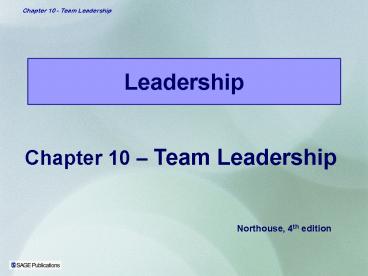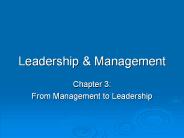Leadership - PowerPoint PPT Presentation
1 / 38
Title:
Leadership
Description:
Should I Intervene Internally or Externally? Leader must: ... Leadership Functions performed internally or externally. Chapter 10 - Team Leadership ... – PowerPoint PPT presentation
Number of Views:111
Avg rating:3.0/5.0
Title: Leadership
1
Leadership
Chapter 10 Team Leadership
Northouse, 4th edition
2
Overview
- Team Leadership Perspective
- Team Leadership Model
- Leadership Decisions
- Leadership Actions
- Team Effectiveness
- Principled Leadership
- How does the Team Leadership Model Work?
3
Historical Perspective of Team Leadership
1920s-1980s
20-30s
40s
50s
60-70s
80s
- Human
- Relations
- movement
- Collaborative
- efforts at
- work
- Group
- dynamics
- Social
- science
- theory
- T group
- Leaders
- role in
- T group
- Organizational
- development
- Team
- leader
- effectiveness
- Quality
- teams
- Benchmarking
- Continuous
- improvement
4
Historical Perspective of Team Leadership 1990s
Parker 1990
90s
- Effectiveness research The use
of teams has led to - Greater productivity
- More effective use of resources
- Better decisions problem solving
- Better-quality products services
- Increased innovation creativity
5
Team Leadership Description
Perspective
- Team research (Ilgen, Hollenbeck Johnson Jundt,
2005) - Focus on team variables
- Role of affective, behavioral cognitive
processes in team success - Team performance viability
- Role of mediating processes such as
- Trusting, bonding, planning, adapting,
structuring learning - Issues
- Difficult to understand the team process because
of its complexity - Leader ineffectiveness is major obstacle to
overall team effectiveness
6
Team Leadership Description
Objectives
- Critical factor in success of organizational
teams understand role of leadership in teams - Ensure team success avoid team failure
- Functions a leader must perform
- Complexity involved in performing these functions
- How performance of these complex functions
relates to actual team performance - Team leadership capacity
- Shared or distributed leadership
- Encompasses entire team
7
Team Leadership Model
Description
- Model provides leader or designated team member
with a mental road map to help - Diagnose team problems, and
- Take appropriate action to correct team problems
- Effective team performance begins with leaders
mental model of the situation - Mental model reflects
- Components of the problem
- Environmental organizational contingencies
8
Team Leadership Model
Description
- Leadership behavior
- Seen as team-based problem solving
- Leader uses discretion
- Which problems need intervention
- Make choices about which solutions are the most
appropriate - Effective leaders have the ability to determine
- What interventions are needed, if any, to solve
team problems
9
Hills Model for Team Leadership
10
Leadership Decisions
- Continue monitoring the team or take action based
on current information - Determine the general task or relational
function of intervention needed - Intervene at internal level (within team) or
external level (teams environment)
11
Leadership Decision 1
Should I Monitor the Team or Take Action?
- Leaders can
- Diagnose, analyze, or forecast problems
(monitoring) or take immediate action to solve a
problem - Focus on problems within the group (internal) or
- Which problems need intervention
- Make choices about which solutions are the most
appropriate - Effective leaders have the ability to determine
- What interventions are needed, if any, to solve
team problems
12
Leadership Decision 1
Should I Monitor the Team or Take Action?
- McGraths critical leadership functions two
dimensions of leadership behavior - Monitoring vs. taking action
- We can diagnose, analyze, or forecast problems
(monitoring) or take immediate action to solve a
problem - Internal group issues vs. external group issues
- Focus on the problems within the group (internal)
or problems outside the group (external) - Two dimensions result in 4 types of group
leadership functions
13
Leadership Decision 1
14
Leadership Decision 2
Should I Intervene to Meet Task or Relational
Needs?
- Leaders can
- Determine if team needs help in dealing with
relational issues or task issues - Task functions include
- Getting job done
- Making decisions
- Solving problems
- Adapting to change
- Making plans
- Achieving goals
15
Leadership Decision 2
Should I Intervene to Meet Task or Relational
Needs?
- Leaders can
- Determine if team needs help in dealing with
relational issues or task issues - Maintenance functions include
- Developing a positive climate
- solving interpersonal problems
- Satisfying members needs
- Developing cohesion
16
Leadership Decision 3
Should I Intervene Internally or Externally?
- Leader must
- Determine what level of team process needs
leadership attention - Internal task or relational team dynamics, if
- Conflict between group members
- Team goals unclear
- External environmental dynamics, if
- Organization not providing proper support to team
17
Leadership Actions
- Leadership Functions performed internally or
externally
18
Leadership Actions
Internal Task Leadership Actions
- Set of skills or actions leader might perform to
improve task performance - Goal focusing (clarifying, gaining agreement)
- Structuring for results (planning, visioning,
organizing, clarifying roles, delegating) - Facilitating decision making (informing,
controlling, coordinating, mediating,
synthesizing, issue focusing) - Training team members in task skills (educating,
developing) - Maintaining standards of excellence (assessing
team and individual performance, confronting
inadequate performance)
19
Leadership Actions
Internal Relational Leadership Actions
- Set of leadership actions leader needs to
implement to improve team relationships - Coaching team members in interpersonal skills
- Collaborating (including, involving)
- Managing conflict and power issues (avoiding
confrontation, questioning ideas)
20
Leadership Actions
Internal Relational Leadership Actions
- Set of leadership actions leader needs to
implement to improve team relationships, contd. - Building commitment and esprit de corps (being
optimistic, innovating, envisioning, socializing,
rewarding, recognizing) - Satisfying individual member needs (trusting,
supporting, advocating) - Modeling ethical and principled practices (fair,
consistent, normative)
21
Leadership Actions
External Environmental Leadership Actions
- Set of skills or behaviors leader needs to
implement to improve environmental interface with
team - Networking and forming alliances in environment
(gather information, increase influence) - Advocating and representing team to environment
- Negotiating upward to secure necessary resources,
support, and recognition for team
22
Leadership Actions
External Environmental Leadership Actions
- Set of skills or behaviors leader needs to
implement to improve environmental interface with
team - Buffering team members from environmental
distractions - Assessing environmental indicators of teams
effectiveness (surveys, evaluations, performance
indicators) - Sharing relevant environmental information with
team
23
Team Effectiveness
- Team effectiveness the desired outcome of
teamwork - Team Performance task accomplishments
- Team Development maintenance of the team
- Researchers studied organizational work teams
developed - Standard of effectiveness
- Criteria of excellence
24
Team Effectiveness
25
Team Effectiveness
- Clear, Elevating Goal
- Clear so that one can tell if performance
objective has been met - Is motivating or involving so that members
believe it is worthwhile and important - Results-Driven Structure
- Need to find the best structure to achieve goals
- Clear team member roles
- Good communication system
- Methods to assess individual performance
- An emphasis on fact-based judgments
26
Team Effectiveness
27
Team Effectiveness
- Unified Commitment
- Teams need a carefully designed and developed
sense of unity or identification (team spirit) - Collaborative Climate
- Trust based on openness, honesty, consistency,
and respect - Integration of individual actions
- Leaders facilitate a collaborative climate by
- Making communication safe
- Demanding and rewarding collaborative behavior
- Guiding the teams problem-solving efforts
- Managing ones own control needs
28
Team Effectiveness
- Standards of Excellence
- Regulated Performance
- Facilitates task completion and coordinated
action - Stimulates a positive pressure for members to
perform at highest levels - How Accomplished
- Requiring results (clear expectations)
- Reviewing results (feedback/resolve issues)
- Rewarding results (acknowledge superior
performance)
29
Team Effectiveness
- External Support and Recognition
- Regulated Performance
- Teams supported by external resources are
- Given the material resources needed to do
their jobs - Recognized for team accomplishments
- Rewarded by tying those rewards to team
members performance, not individual achievement
30
Team Effectiveness
- Principled Leadership
- Influences team effectiveness through four sets
of processes (Zaccaro et al., 2001) - Cognitive - Facilitates teams understanding of
problems confronting them - Motivational - Helps team become cohesive
capable by setting high performance standards
helping team to achieve them - Affective - Assists team in handling stressful
circumstances by providing clear goals,
assignments, strategies - Integrative - Helps coordinate teams activities
through matching member roles, clear performance
strategies, feedback, adapting to environmental
changes
31
How Does the Team Leadership Approach Work?
- Focus of Team Leadership
- Strengths
- Criticisms
- Application
32
Team Leadership
Focus
- Model provides a cognitive map to identify group
needs and offers suggestions on appropriate
corrective actions - Model assists leader in making sense of the
complexity of groups and provides suggested
actions to improve group effectiveness
33
Team Leadership
Focus
- How does the model work?
- 1st - Leader engages leader mediation process
- Decides appropriate action - to monitor or take
action - If teams function satisfactory no action
- If monitoring reveals action needed which
level(s) - internal or external
34
Team Leadership
Focus
- How does the model work?
- 2nd Determining exact intervention needed
- Internal relationship problem
- Internal task problem
- External environmental problem
- 3rd Determine action needed or which level to
intervene
35
Team Leadership
Focus
- How does the model work?
- 4th Decide to intervene at any or all 3 levels
- Address the individual internal, relational
- Clarify group roles internal, task
- Negotiate of team with higher up in organization
- external
36
Strengths
- Provides answers to what constitutes excellent
teams - Provides a cognitive guide that assists leaders
in designing and maintaining effective teams - Recognizes the changing role of leaders and
followers in organizations - Can be used as a tool in group leader selection
37
Criticisms
- Complete model has not been totally supported or
tested - May not be practical as the model is complex and
doesnt provide easy answers for difficult leader
decisions - Fails to provide much guidance for handling
everyday interactions and complications of team
management - More focus required on how to teach and provide
skill development in areas of diagnosis and
action taking
38
Application
- Useful in leader decision making
- Can be used as a team diagnostic tool































